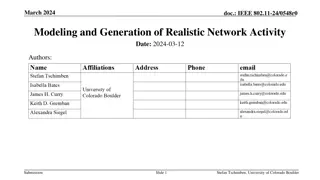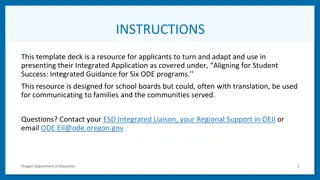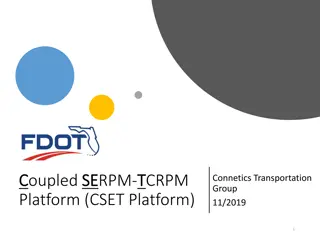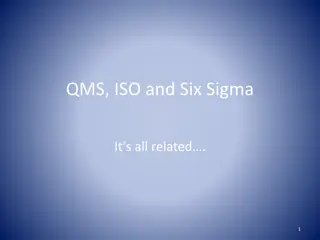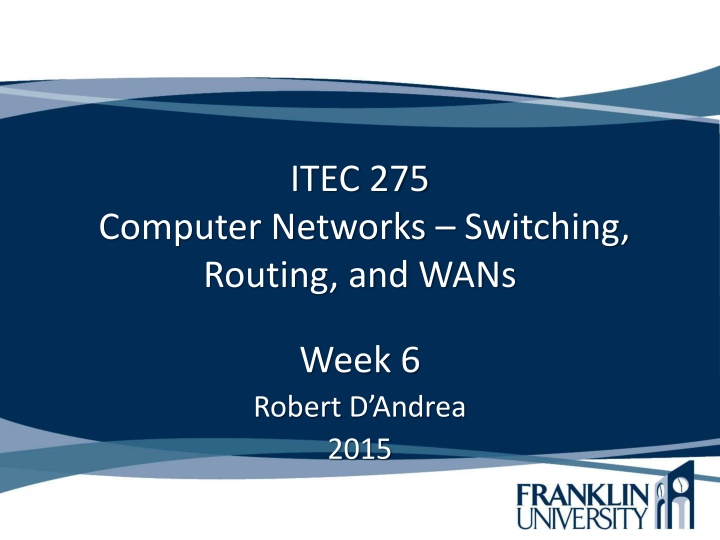
IP Address Assignment and Regional Internet Registries
Explore the importance of structured IP addressing, advantages of hierarchical organization, public IP address management by IANA, and the roles of Regional Internet Registries (RIRs) like ARIN, RIPE NCC, APNIC, LACNIC, and AfriNIC in allocating IP addresses.
Download Presentation

Please find below an Image/Link to download the presentation.
The content on the website is provided AS IS for your information and personal use only. It may not be sold, licensed, or shared on other websites without obtaining consent from the author. If you encounter any issues during the download, it is possible that the publisher has removed the file from their server.
You are allowed to download the files provided on this website for personal or commercial use, subject to the condition that they are used lawfully. All files are the property of their respective owners.
The content on the website is provided AS IS for your information and personal use only. It may not be sold, licensed, or shared on other websites without obtaining consent from the author.
E N D
Presentation Transcript
ITEC 275 Computer Networks Switching, Routing, and WANs Week 6 Robert D Andrea 2015
Administrative Midterm Exam The midterm exam will be administered the eighth week of the term, October 26 through 31, 2015.
Agenda Learning Activities IP Addressing Hierarchical structure Static and Dynamic Assignment IPv6 IPv4 to IPv6 Transition Methods SNMP Monitoring
Guidelines for Addressing and Naming Use a structured model for addressing and naming. A topology may be useful for viewing the hierarchy in the network and recognize address boundaries. Assign addresses and names hierarchically Decide in advance if you will use Central or distributed authority for addressing and naming. Determine who is in charge of delegating addresses and naming conventions. Public or private addressing (IANA or RFC 1918) Static or dynamic addressing and naming (DHCP Dynamic Host Configuration Protocol)
Advantages of Structured Models for Addressing & Naming Easier to understand by Reading network maps Operating network management software Recognize devices in protocol analyzer traces Meeting goals for usability Designing filters on firewalls and routers Implementing route summarization The Structured Model for addressing provides the IP address with meaning and hierarchical organization.
Public IP Addresses Managed by the Internet Assigned Numbers Authority (IANA) Users are assigned IP addresses by Internet service providers (ISPs). ISPs obtain allocations of IP addresses from their appropriate Regional Internet Registry (RIR) Internet Assigned Numbers Authority (IANA). IANA allocates IP addresses to the Regional Internet Registries (RIRs)
Regional Internet Registries (RIR) American Registry for Internet Numbers (ARIN) serves North America and parts of the Caribbean. RIPE Network Coordination Centre (RIPE NCC) serves Europe, the Middle East, and Central Asia. Asia-Pacific Network Information Centre (APNIC) serves Asia and the Pacific region. Latin American and Caribbean Internet Addresses Registry (LACNIC) serves Latin America and parts of the Caribbean. African Network Information Centre (AfriNIC) serves Africa.
Static Vs. Dynamic Addressing Bases for addressing criteria The number of end systems The likelihood of needing to renumber The need for high availability Security requirements The importance of tracking addresses Whether end systems need additional information (DHCP can provide more than just an address)
IPv4 Address Classes Classes Range CIDR Subnet Mask A 1 126 /8 255.0.0.0 B 128 - 191 /16 255.255.0.0 C 192 - 223 /24 255.255.255.0 D 224 239 N/A Multicast E 240 255 N/A
Private IPv4 Addresses No. of addresses Start End 24-bit block (/8 prefix, 1 A) 10.0.0.0 10.255.255.255 16777216 20-bit block (/12 prefix, 16 B) 172.16.0.0 172.31.255.255 1048576 16-bit block (/16 prefix, 256 C) 192.168.0.0 192.168.255.255 65536
IPv4 Addresses Class Bits Traditional routing, also known as classful routing. No information is transmitted about the prefix length. The hosts and router examine the first three bits of the IP address to determine its class. Class A 00000000 = 0 01111111 = 127
IPv4 Addresses Class Bits Class B 10000000 = 128 10111111 = 191 Class C 11000000 = 192 11011111 = 223
IPv4 Addresses Caveats 1. Network ID zero is always reserved as the universal gateway 2. IP addresses 127.0.0.0 127.255.255.255 is considered loopback. IP address 127.0.0.1 address is most commonly used address for loopback. 3. Private IP addresses are not routable on the Internet.
Parts of an IPv4 Address 32 Bits Prefix Host Prefix Length
Prefix Length An IPv4 address is accompanied by an indication of the prefix length Classful dotted-decimal notation subnet mask 192.168.55.1 255.255.255.0 Classless Inter Domain Routing (CIDR) / Length 192.168.55.1/24
IPv4 Address Subnet Notations Subnet size 32 bits long (4 octets) Specifies which part of an IP address is the network/subnet field and which part is the host field The network/subnet portion of the mask is all 1s in binary. The host portion of the mask is all 0s in binary. Convert the binary expression back to dotted-decimal notation for entering into configurations. Alternative IPv4 address representation Use slash notation (for example /24) Specifies the number of 1s
IPv4 Address Subnet Notation Classless Inter Domain Routing (CIDR) notation identifies the prefix length with a length field, followed by a slash. Example: 10.1.0.1/16 The prefix length is 16 bits long. The subnet mask would be 255.255.0.0.
Shorthand Subnet Mask Decimal Shorthand 128 192 224 240 248 252 254 255 The shorthand notations represent how many bits are used in the subnet mask. The minimum subnet mask for a Class C address must be 255.255.255.0, which is 24 bits (8 bits in each octet), or CIDR notation /24. Binary 10000000 11000000 11100000 11110000 11111000 11111100 11111110 11111111 CIDR /25 /26 /27 /28 /29 /30 /31 /32
Shorthand Subnet Mask Available subnets Usable hosts per subnet Total Prefix size Network mask usable hosts /24 255.255.255.0 1 254 254 /25 255.255.255.128 2 126 252 /26 255.255.255.192 4 62 248 /27 255.255.255.224 8 30 240 /28 255.255.255.240 16 14 224 /29 255.255.255.248 32 6 192 /30 255.255.255.252 64 2 128 2* /31 255.255.255.254 128 256
Shorthand Subnet Mask * The prefix size /31, is only achievable when using a point-to-point type network connection.
Shorthand Subnet Mask 2^0 = 1 2^1 = 2 2^2 = 4 2^3 = 8 2^4 = 16 2^5 = 32 2^6 = 64 2^7 = 128 2^8 = 256
Subnet Mask Example 11111111 11111111 11111111 00000000 What is this in slash notation? What is this in dotted-decimal notation?
Subnet Mask Example 11111111 11111111 11111111 00000000 What is this in slash notation? /24 What is this in dotted-decimal notation? 255.255.255.0
Subnet Mask Example 11111111 11111111 11110000 00000000 What is this in slash notation? What is this in dotted-decimal notation?
Subnet Mask Example 11111111 11111111 11110000 00000000 What is this in slash notation? /20 What is this in dotted-decimal notation? 255.255.240.0
One More Subnet Mask Example 11111111 11111111 11111000 00000000 What is this in slash notation? What is this in dotted-decimal notation?
One More Subnet Mask Example 11111111 11111111 11111000 00000000 What is this in slash notation? 21 What is this in dotted-decimal notation? 255.255.248.0
Private IPv4 Addresses Caveat with Private Addressing Outsourcing network management responsibilities to an outside vendor. With private addressing, the internal networks are not advertised to the outside. NAT problems would occur handling network management protocols like Simple Network Management Protocol (SNMP). Advantages with Private Addressing Any user may use any of the reserved blocks. Typically, a network administrator will divide a block into subnets; for example, many home routers automatically use a default address range of 192.168.0.0 through 192.168.0.255 (192.168.0.0/24 block).
Network Address Translation (NAT) Static translations One private address to one public address Used for servers that must be visible to the public network Dynamic translations Many unregistered addresses to one registered address from a pool of addresses (similar to PBX) Used for workstations that only connect to the public network when required Combination of both translations Used by most organizations
Network Address Translation (NAT) Network Address Translation (NAT) is a methodology of modifying network address information in Internet Protocol (IP) datagram packet headers while they are in transit across a traffic routing device for the purpose of remapping one IP address space into another.
Address Usage in the Enterprise Figure 6-3
Classful IP Addressing Class First Few Bits First Byte Prefix Length Intent A B C D E 0 10 110 1110 1111 1-126* 128-191 192-223 224-239 240-255 8 16 24 NA NA Very large networks Large networks Small networks IP multicast Experimental *Addresses starting with 127 are reserved for IP traffic local to a host.
Division of the Classful Address Space Class Prefix Length Number of Addresses per Network A B C 8 16 24 224-2 = 16,777,214 216-2 = 65,534 28-2 = 254
Classless Addressing Prefix/host boundary can be anywhere Less wasteful Supports route summarization Also known as Aggregation Super netting Classless routing Classless inter-domain routing (CIDR) Prefix routing
Classless Addressing Classless routing protocols transmit a prefix length with the IP address. This allows classless routing protocols to group networks into one entry and use the prefix length to specify which networks are grouped. Classless routing protocols include RIPv2, EIGRP, OSPF, BGP, and IS-IS.
Definitions Sub-netting is when you take one large network and break it into a bunch of smaller networks. A subnet mask is a 32-bit value that allows the recipient of IP packets to distinguish the network ID portion of the IP address from the host ID portion of the IP address. The 1s in the subnet mask represent the position referred to as the network or subnet addresses.
Routing Protocols Distance vector finds the best path to a remote network by judging distance. Each time the packet goes through a router, that s called or considered a hop. Link State, also called shortest path first protocols, the routers each create three separate tables. One to keep track of directly attached neighbors. A second table to determine the topology of the entire internetwork. The third table is used as a routing table.
Routing Protocols With a Distance Vector protocol, the path or 'route' chosen would be from A to B directly over the ISDN serial link, even though that link is about 10 times slower than the indirect route from A to C to D to B. A Link State protocol would choose the A to C to D to B path because it's using a faster medium (100 Mb Ethernet). In this example, it would be better to run a Link State routing protocol, but if all the links in the network are the same speed, then a Distance Vector protocol would be the best choice.
Supernetting 172.16.0.0 172.17.0.0 172.18.0.0 Branch-Office Router 172.19.0.0 Enterprise Core Network Branch-Office Networks Move prefix boundary to the left Branch office advertises 172.16.0.0/14
Addressing Hierarchy Figure 6-6 Page 387
Route summarization Summary 192.168.0/21 Figure 6-5 Page 386
172.16.0.0/14 Summarization First Octet in Decimal First Octet in binary 172 10101100 Second Octet in Decimal Second Octet in Binary 16 17 18 19 00010000 00010001 00010010 00010011
172.16.0.0/14 Summarization First Octet in Decimal First Octet in binary 172 10101100 Second Octet in Decimal Second Octet in Binary 16 17 18 19 00010000 00010001 00010010 00010011
Dis-Continuous Subnets In traditional classful IP addressing it was assumed that subnets would be contiguous. What that means is basically that to get from one subnet of some major network to any other subnet of that network, you would go through only subnets of that network. For example if you were in subnet 10.10.10.0 and you were going to 10.30.30.0 you might go through 10.20.20.0. That would be contiguous.
Dis-Continuous Subnets Discontiguous subnets means that to go from one subnet of a network to another subnet of that network you must go through subnets of a different network. For example if you are in subnet 10.10.10.0 and to get to 10.30.30.0 you must go through 172.16.10.0 then that would be discontiguous.
Dis-contiguous Subnets Area 0 Network 192.168.49.0 Router A Router B Area 1 Area 2 Subnets 10.108.16.0 - 10.108.31.0 Subnets 10.108.32.0 - 10.108.47.0
Dis-contiguous Subnets Router A advertises access to network 10.0.0.0. Router B ignores the advertisement because it can already get to network 10.0.0.0. This occurs in both directions with the routers. Classless routing protocol is one method for solving this problem.
A Mobile Host Mobile Host is a host that moves from one network to another and has a statically defined IP address. The administrator can move a mobile host to another and configure a router with a host-specific route to specify that traffic for the host should be routed through that router. Classless routing protocols match the longest prefix. Example: 10.108.16.0/20 and 10.108.16.1/32

